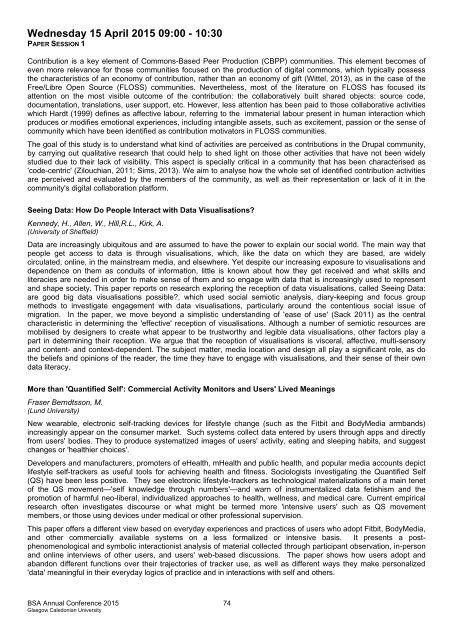Programme full
Programme full
Programme full
Create successful ePaper yourself
Turn your PDF publications into a flip-book with our unique Google optimized e-Paper software.
Wednesday 15 April 2015 09:00 - 10:30<br />
PAPER SESSION 1<br />
Contribution is a key element of Commons-Based Peer Production (CBPP) communities. This element becomes of<br />
even more relevance for those communities focused on the production of digital commons, which typically possess<br />
the characteristics of an economy of contribution, rather than an economy of gift (Wittel, 2013), as in the case of the<br />
Free/Libre Open Source (FLOSS) communities. Nevertheless, most of the literature on FLOSS has focused its<br />
attention on the most visible outcome of the contribution: the collaboratively built shared objects: source code,<br />
documentation, translations, user support, etc. However, less attention has been paid to those collaborative activities<br />
which Hardt (1999) defines as affective labour, referring to the immaterial labour present in human interaction which<br />
produces or modifies emotional experiences, including intangible assets, such as excitement, passion or the sense of<br />
community which have been identified as contribution motivators in FLOSS communities.<br />
The goal of this study is to understand what kind of activities are perceived as contributions in the Drupal community,<br />
by carrying out qualitative research that could help to shed light on those other activities that have not been widely<br />
studied due to their lack of visibility. This aspect is specially critical in a community that has been characterised as<br />
'code-centric' (Zilouchian, 2011; Sims, 2013). We aim to analyse how the whole set of identified contribution activities<br />
are perceived and evaluated by the members of the community, as well as their representation or lack of it in the<br />
community's digital collaboration platform.<br />
Seeing Data: How Do People Interact with Data Visualisations?<br />
Kennedy, H., Allen, W., Hill,R.L., Kirk, A.<br />
(University of Sheffield)<br />
Data are increasingly ubiquitous and are assumed to have the power to explain our social world. The main way that<br />
people get access to data is through visualisations, which, like the data on which they are based, are widely<br />
circulated, online, in the mainstream media, and elsewhere. Yet despite our increasing exposure to visualisations and<br />
dependence on them as conduits of information, little is known about how they get received and what skills and<br />
literacies are needed in order to make sense of them and so engage with data that is increasingly used to represent<br />
and shape society. This paper reports on research exploring the reception of data visualisations, called Seeing Data:<br />
are good big data visualisations possible?, which used social semiotic analysis, diary-keeping and focus group<br />
methods to investigate engagement with data visualisations, particularly around the contentious social issue of<br />
migration. In the paper, we move beyond a simplistic understanding of 'ease of use' (Sack 2011) as the central<br />
characteristic in determining the 'effective' reception of visualisations. Although a number of semiotic resources are<br />
mobilised by designers to create what appear to be trustworthy and legible data visualisations, other factors play a<br />
part in determining their reception. We argue that the reception of visualisations is visceral, affective, multi-sensory<br />
and content- and context-dependent. The subject matter, media location and design all play a significant role, as do<br />
the beliefs and opinions of the reader, the time they have to engage with visualisations, and their sense of their own<br />
data literacy.<br />
More than 'Quantified Self': Commercial Activity Monitors and Users' Lived Meanings<br />
Fraser Berndtsson, M.<br />
(Lund University)<br />
New wearable, electronic self-tracking devices for lifestyle change (such as the Fitbit and BodyMedia armbands)<br />
increasingly appear on the consumer market. Such systems collect data entered by users through apps and directly<br />
from users' bodies. They to produce systematized images of users' activity, eating and sleeping habits, and suggest<br />
changes or 'healthier choices'.<br />
Developers and manufacturers, promoters of eHealth, mHealth and public health, and popular media accounts depict<br />
lifestyle self-trackers as useful tools for achieving health and fitness. Sociologists investigating the Quantified Self<br />
(QS) have been less positive. They see electronic lifestyle-trackers as technological materializations of a main tenet<br />
of the QS movement—'self knowledge through numbers'—and warn of instrumentalized data fetishism and the<br />
promotion of harmful neo-liberal, individualized approaches to health, wellness, and medical care. Current empirical<br />
research often investigates discourse or what might be termed more 'intensive users' such as QS movement<br />
members, or those using devices under medical or other professional supervision.<br />
This paper offers a different view based on everyday experiences and practices of users who adopt Fitbit, BodyMedia,<br />
and other commercially available systems on a less formalized or intensive basis. It presents a postphenomenological<br />
and symbolic interactionist analysis of material collected through participant observation, in-person<br />
and online interviews of other users, and users' web-based discussions. The paper shows how users adopt and<br />
abandon different functions over their trajectories of tracker use, as well as different ways they make personalized<br />
'data' meaningful in their everyday logics of practice and in interactions with self and others.<br />
BSA Annual Conference 2015 74<br />
Glasgow Caledonian University


